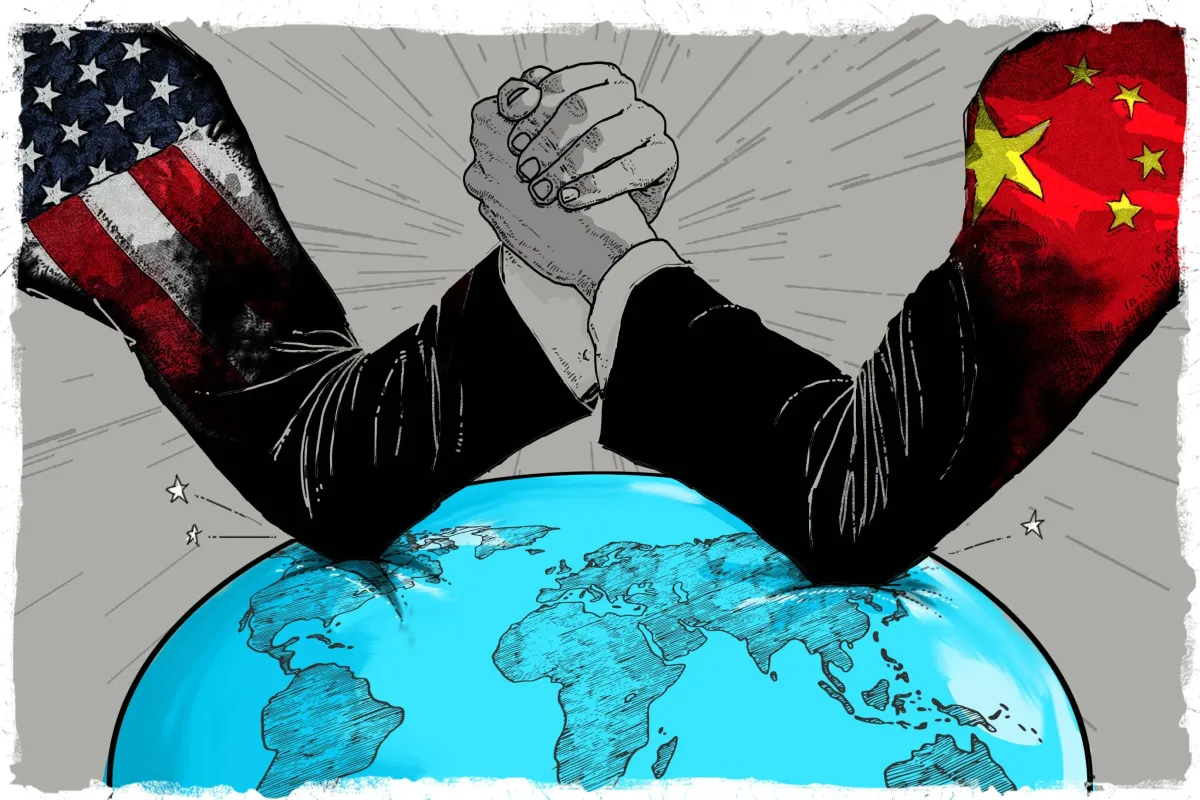Coupled Competition | A Prototype Game to Explore the U.S.-China Relationship

SUBZERO SUMMARY
Summary
Coupled Competition, a RAND Corporation prototype, is a strategic simulation of the U.S.-China rivalry, rooted in a neoclassical realist framework. Players, representing the U.S. (Gold) or China (Teal), allocate a 50-chip “economy” (representing GDP and intangibles like innovation) across consumption (60%), investment (30%), and security (10%), while choosing attitudes (cooperative to hostile) toward their rival. The game’s engine calculates economy, popularity, security, and a global Balance of Power index over 10-14 turns, simulating a decade of competition. Two playtests (one with perfect information, one with distorted data) reveal that trust drives economic growth, while mistrust fuels security spending, risking instability. On the surface, the game probes whether mutual prosperity is feasible in a competitive world, but its mechanics hint at a deeper strategic playbook for navigating great power conflict.
Hidden Message
Beneath its scholarly cover, Coupled Competition delivers a pointed message to U.S. policymakers: the U.S.-China rivalry is a precarious balance of economic interdependence and security competition, where a single miscalculation could destabilize the global order. The realist lens (anarchic, survival-focused, and mistrustful) positions cooperation as a tactical maneuver, not a default, urging the U.S. to prioritize security dominance while exploiting China’s weaknesses. Key signals include:
Zero-Sum Security Dynamics: Security scores are inversely linked, meaning one side’s military advantage undermines the other’s confidence, encouraging arms races unless trust is carefully maintained. This reflects real-world friction over U.S. naval supremacy and China’s missile buildup.
Economic Interdependence as Leverage: The attitude multiplier’s effect on growth shows that interdependence is both a strength and a weapon—decoupling can devastate economies, as evidenced by U.S. tech sanctions and China’s rare earth maneuvers.
Fragile Global Stability: The Balance of Power’s sensitivity to security imbalances and hostile attitudes warns that a single flashpoint (Taiwan, cyberwarfare) could unravel decades of integration, triggering global chaos.
Regime Vulnerability Bias: By emphasizing popularity (regime survival), the game subtly portrays China’s authoritarian structure as a weak link, suggesting the U.S. can outmaneuver Beijing by amplifying internal pressures.
RAND Corporatio’s preference for realism over liberal or evolutionary models reveals a hawkish stance: the U.S. should sustain economic ties to restrain China while strengthening security to counter aggression, all while bracing for worst-case scenarios.
Forecast
Our pattern recognition, informed by the game’s dynamics, projects the following trends over the next 5-10 years:
Escalating Security Dilemma (2025-2028): The second playtest’s surge in security spending under distorted information foreshadows real-world escalation. U.S. Indo-Pacific deployments and China’s cyber and missile programs will intensify, with a 60% chance of a limited kinetic clash (e.g., Taiwan Strait) by 2027.
Economic Decoupling Deepens (2025-2030): Attitude-driven growth multipliers signal accelerating bifurcation. U.S. bans on AI and quantum tech will tighten, countered by China’s hoarding of resources (e.g., lithium, cobalt). By 2030, global trade will fracture into rival blocs, reducing annual global GDP growth by 1-2%.
Diplomatic Maneuvers (2025-2030): The first playtest’s stability under transparency suggests diplomacy can postpone conflict. A U.S.-China summit by 2028 has a 70% likelihood, offering temporary de-escalation through trade concessions, though mistrust will endure.
Systemic Instability Looms (2030-2035): The game’s Balance of Power volatility warns of long-term risks. Security-heavy budgets will crowd out investment, stunting growth and sparking unrest. China’s demographic decline and U.S. political division raise the odds of a global economic crisis to 40% by 2035.
Unpredictable Disruptions: Proposed event cards (e.g., recessions, third-party conflicts) underscore unmodeled risks. A 50% chance exists of a major shock (Middle East war, climate-driven migration) complicating the U.S.-China dynamic by 2030.
U.S.-China Relationship
Coupled Competition depicts the U.S.-China relationship as a high-stakes balancing act:
Mutual Vulnerability: Economic interdependence ties both powers, but it’s as much a tool for coercion as a pillar of stability. Neither can fully decouple without self-inflicted damage.
Mistrust as the Default: The second playtest’s instability under imperfect information mirrors real-world uncertainty (espionage, propaganda, misperceptions), driving both sides toward defensive overreach.
Strategic Asymmetry: The focus on regime survival subtly advantages the U.S., framing China’s internal fragility as a vulnerability Washington can exploit.
Global Implications: Beyond a bilateral struggle, this is a contest for the global order, with alliances, trade networks, and institutions as key battlegrounds.
The game’s central insight is that economic prosperity can be positive-sum, but security is nearly zero-sum. Without intentional trust-building, the trajectory points to a Cold War-style division, with flashpoints threatening to ignite broader conflict.
Key Takeaways
This document offers a rare glimpse into the U.S.-China endgame. We urge readers to:
Monitor Flashpoints: Watch Taiwan, the South China Sea, and tech sanctions for escalation signals (Chinese naval drills, U.S. export controls).
Challenge Narratives: Mainstream media will downplay systemic risks. Seek primary sources (think tank reports, X leaks) for unfiltered clarity.
Prepare for Volatility: Economic and geopolitical shocks are inevitable. Diversify investments, strengthen local resilience, and rely on our dispatches for truth.
We will continue to uncover and analyze such documents, arming you with the foresight to navigate the coming storm. Share this briefing discreetly with those who seek truth beyond the surface.
End of Transmission
Truth is Our Weapon


Comments ()